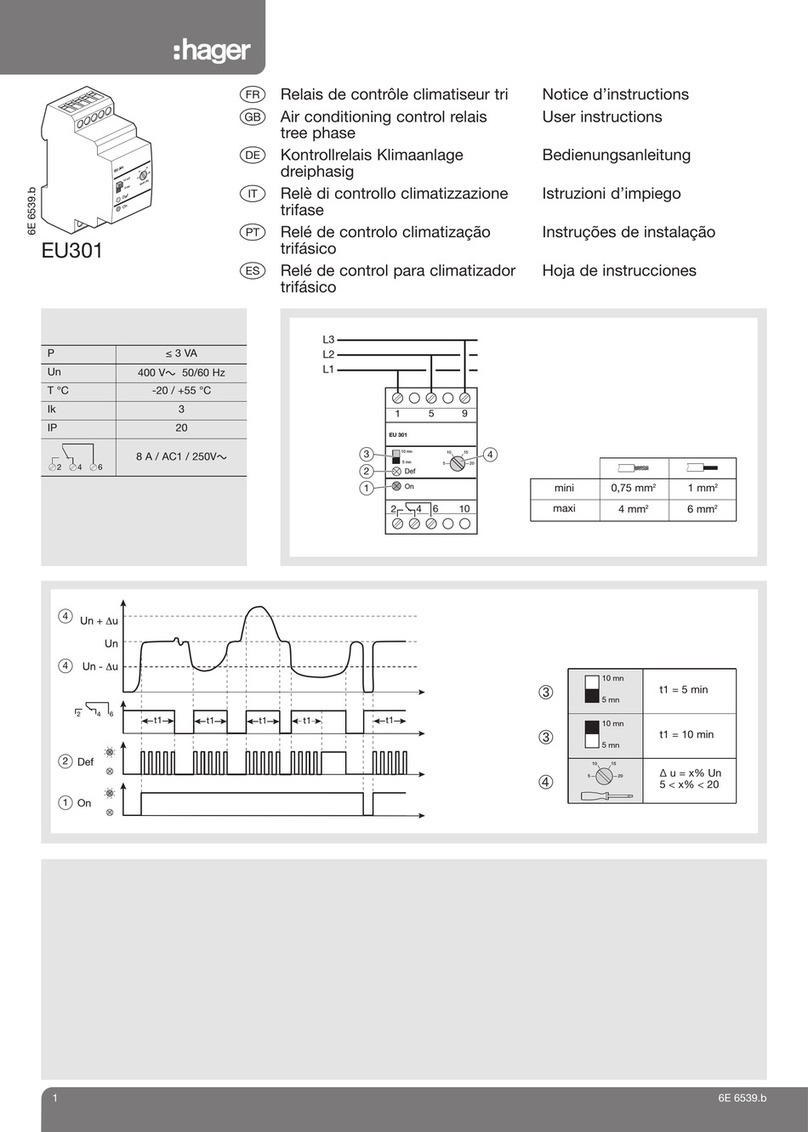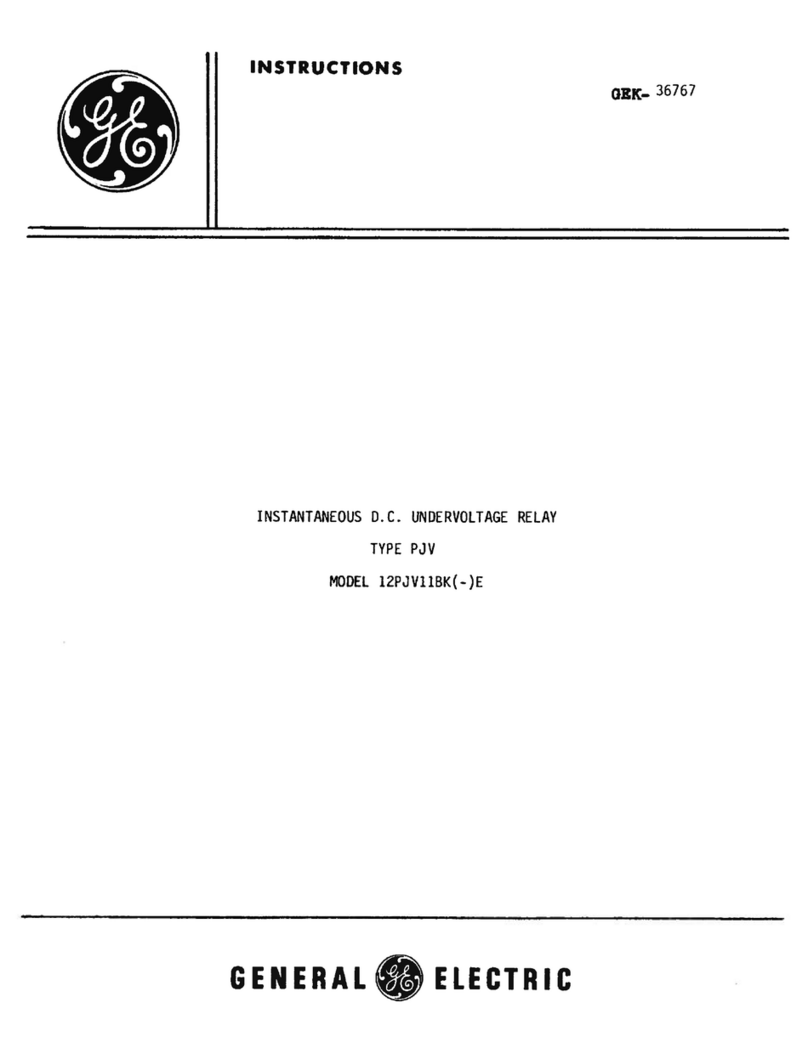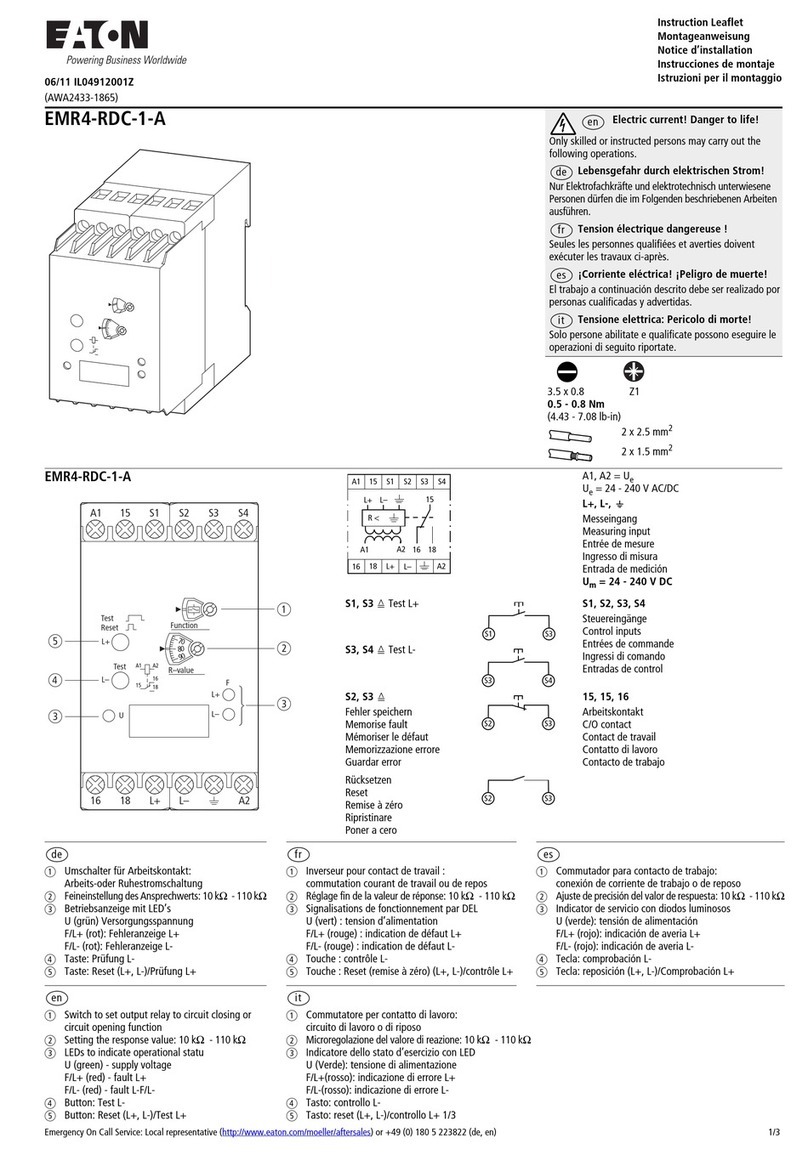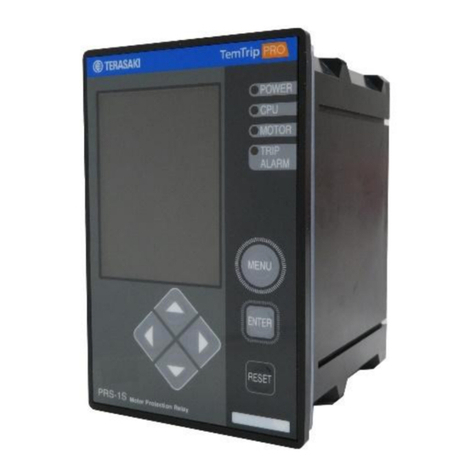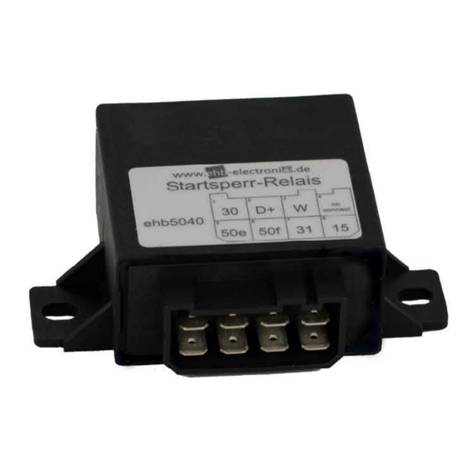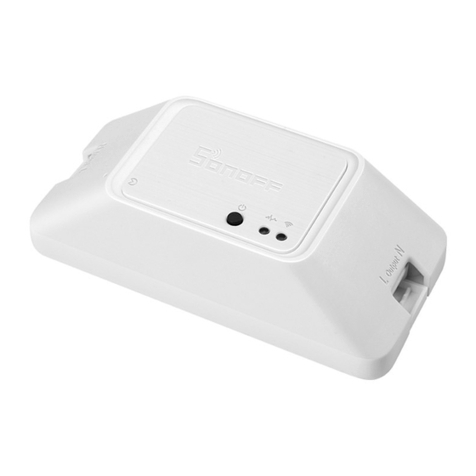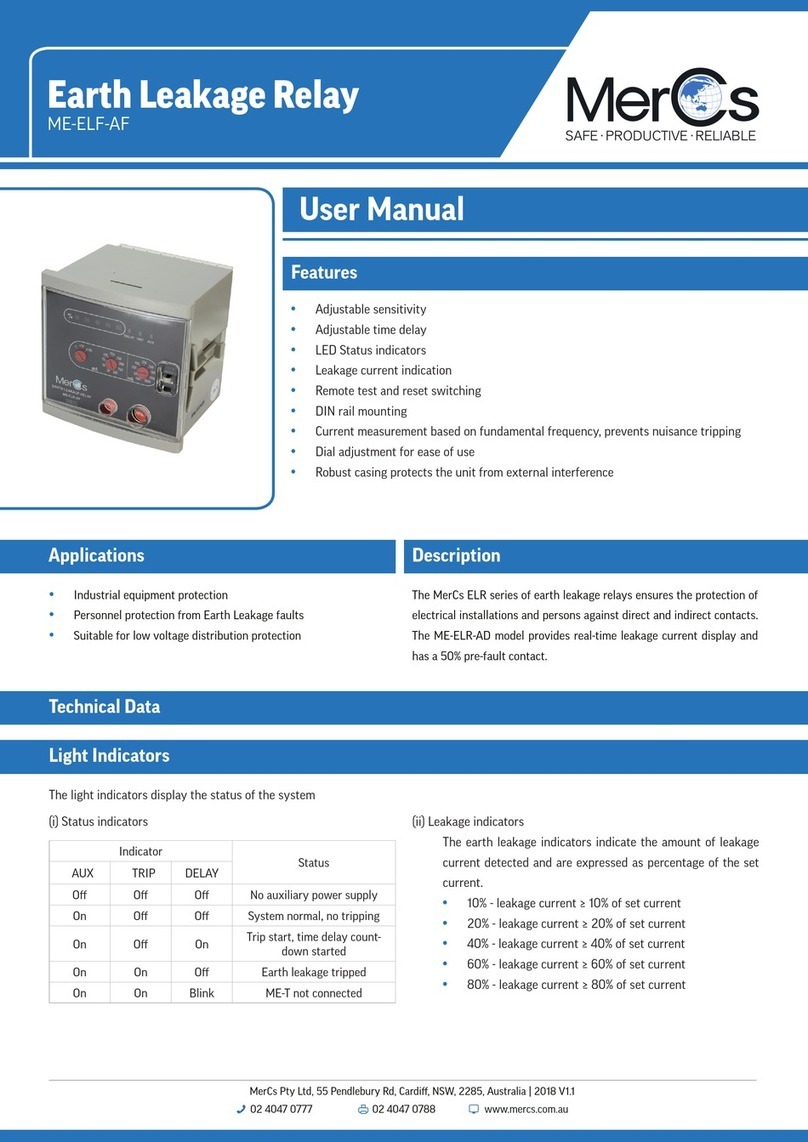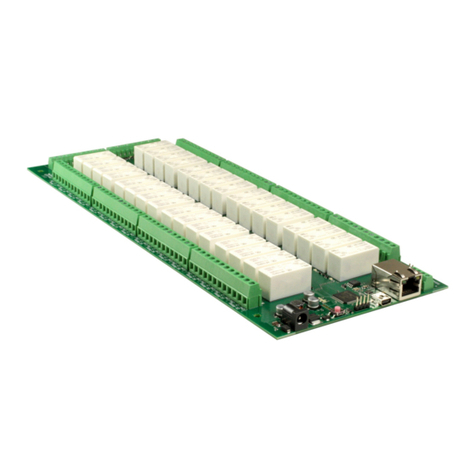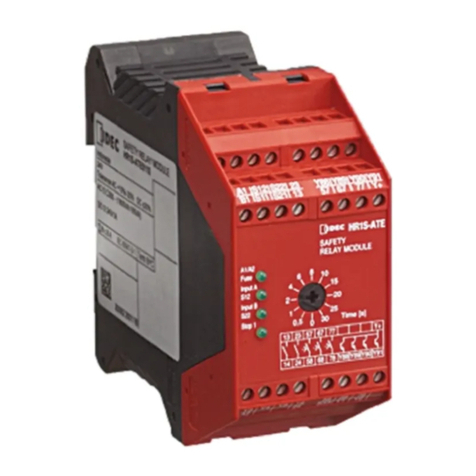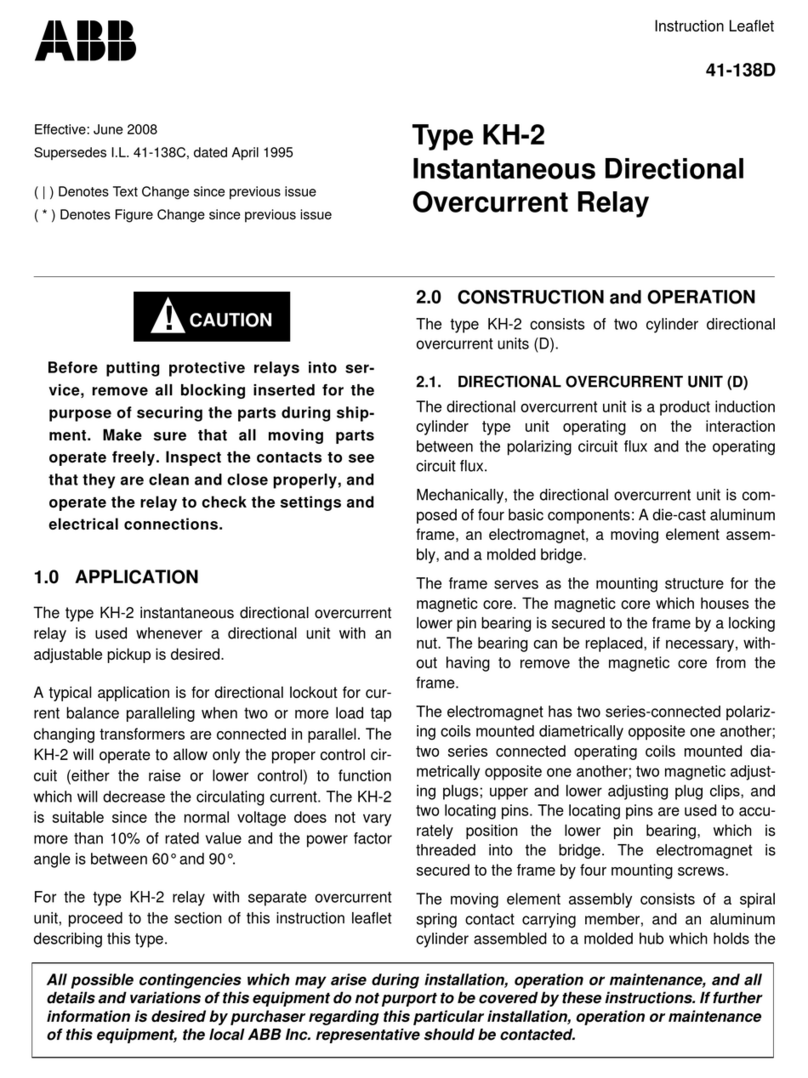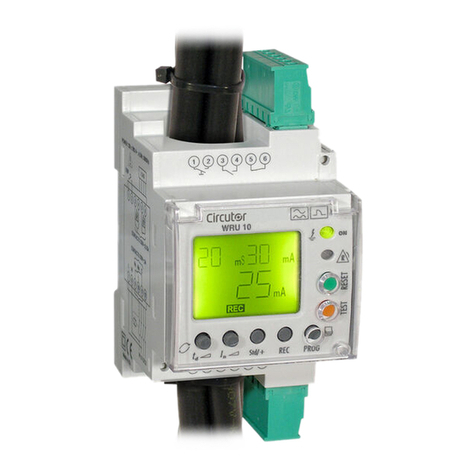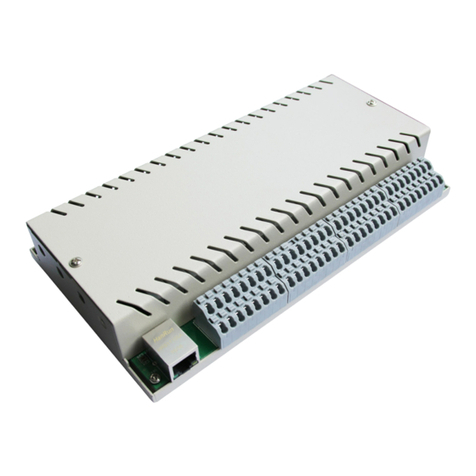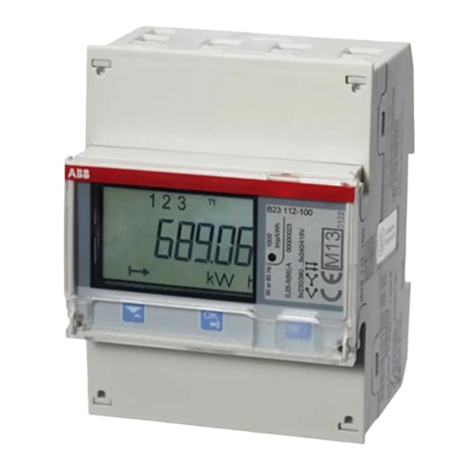SEB IFX4NR User manual

DIVISIONE ELETTRONICA E SISTEMI
IFX4NR
DIGITAL OVERCURRENT AND EARTH FAULT
MULTIFUNCTION RELAY
WITH RECLOSING FUNCTION
USER MANUAL
P500D802 July 2004


SEB Divisione Elettronica e Sistemi INDEX
INDEX
1GENERAL CHARACTERISTICS..................................................................................1
1.1 Auto-reclosing function (ANSI 79) .........................................................................4
1.2 Pole wearing monitoring function..........................................................................5
1.3 Breaker failure function..........................................................................................6
2FRONT PANEL KEYS ..................................................................................................7
3FRONT PANEL LED SIGNALINGS..............................................................................8
4PROGRAMMING AND TEST .......................................................................................9
4.1 How to program the protection relay......................................................................9
4.2 How to modify a visualized parameter.................................................................10
4.3 Reset ...................................................................................................................10
4.4 Test of output relays ............................................................................................11
5DISPLAY AND PROGRAMMING ...............................................................................12
5.1 Standard display..................................................................................................12
5.2 Visualization structure .........................................................................................13
5.3 Address and Time (fig. 1) ....................................................................................16
5.4 Protection function selection (fig. 1).....................................................................17
5.5 Nominal values set-up (fig. 2)..............................................................................17
5.6 Thresholds and time delays set-up (fig. 2)...........................................................19
5.7 ANSI 79 – Auto-reclosing function programming – (fig. 2)...................................21
5.8 Pole wearing monitor programming (fig. 2)..........................................................22
5.9 Breaker – failure function programming (fig. 2) ...................................................23
5.10 Output relays programming (fig. 2) ......................................................................23
5.11 Digital inputs function programming (fig. 2) .........................................................26
5.12 Parameter values visualization (fig. 3).................................................................27
5.13 Events (fig. 3) ......................................................................................................29
5.14 Trip counters and pole wear index (fig. 3) ...........................................................31
6INSTALLATION ..........................................................................................................33
6.1 Supplied kit..........................................................................................................33
6.2 Cabling ................................................................................................................34
6.3 Relays R3 and R4 – Signaling / Command set-up ..............................................37
6.4 RS485 serial communication port........................................................................37
7TIME DEPENDENT CURVES ....................................................................................39
8TECHNICAL CHARACTERISTICS.............................................................................40
9TABLES......................................................................................................................41
Information printed in this manual subject to change without prior notice.
This manual must not be reproduced in whole or in part, in any form or by any means
without the express written permission of SEB Divisione Elettronica e Sistemi.

SEB Divisione Elettronica e Sistemi GENERAL CHARACTERISTICS
1
1 GENERAL CHARACTERISTICS
The protection relay IFX4NR performs functions such as overcurrent and earth fault
protection relay with the following additional functionalities:
•auto - reclosing function
•circuit - breaker failure function
•circuit - breaker poles wearing monitoring
The user can select one of the protection functions listed in the table below.
Functions ANSI Measured currents
Two-phase overcurrent 50 51 I1, I2
Three-phase overcurrent 50 51 I1, I2, I3
Two-phase overcurrent + earth fault 50 51 51N I1, I2, Io
Three-phase overcurrent + earth fault 50 51 51N I1, I2, I3, Io
Earth fault (non directional) 51 N Io
Stator earth fault (95%) 64 S Io
Transformer case earth fault 64 T Io
All the set-up and measured parameters can be visualized on the front panel display and
transmitted on the RS485 communication serial port.
THRESHOLDS - the following thresholds are available:
•phase overcurrent thresholds I> , I >> , I>>>
•earth fault overcurrent thresholds Io>, Io>>, Io>>>
•poles wearing index threshold I2T
The available settings for each threshold are listed in Table A.
Related to each threshold, partial and total counters of TRIP conditions are available.
TRIP DELAYS - a programmable time delay (TI) is available for each overcurrent
threshold; it can be programmed as definite time for all threshold available and dependent
time in compliance with IEC 255-4 standard for the thresholds I> and Io>.
For each threshold programmed as definite time, an additional programmable time delay
(TA) is available; the additional time delay is added to time delay TI. The additional time
delay activation is controlled by the digital inputs to allow the use of the IFX4NR relay with
cooperating protection relays.
The available settings for each timers are listed in Table A.
OUTPUT RELAYS - the IFX4NR controls 4 output relays (named R1, R2, R3 and R4);
these relays can be programmed to be activated on START or TRIP conditions of one or
more thresholds.

SEB Divisione Elettronica e Sistemi GENERAL CHARACTERISTICS
2
START instantaneous activation of the output relay when at least
one of the measured currents exceeds the programmed
threshold value
TRIP activation of the output relay when the programmed time
delay (TI or TI+TA) related to a threshold expires.
The available relays can also be programmed to perform functions related to the auto-
reclosing ANSI 79 operations as:
•circuit breaker close command issue
•reclosing operations successfully completed (79 OK)
•reclosing operations failed (79 FR)
•reclosing function in progress (79 ON)
or:
•BREAKER FAILURE signaling
•TRIP (open circuit breaker) ON EXTERNAL COMMAND
•POLE WEARING INDEX threshold signaling
The quiescent state of each single relay R1, R2, R3 and R4 can be programmed as
normally energized (ON) or normally de-energized (OFF).
An additional relay R5 (normally energized) is controlled by the self-diagnosis routines to
report detected fault conditions.
DIGITAL INPUTS - there are available 3 digital inputs to activate the following functions
(when enabled by the programmed set-up):
•additional time delay (related to one or more thresholds)
•on/off thresholds
•STATUS function (recording of measures on external event)
•pilot wire fault monitoring
•circuit breaker OPEN/CLOSE status (related to ANSI 79 function)
•circuit breaker OPEN/CLOSE command detection (ANSI 79)
•circuit breaker CLOSE command from external protection
For each digital input can be programmed the condition that activates the related
functions:
HI voltage = > 20 V dc / ac
LO voltage = 0 ÷ 10 V dc / ac
The digital input acquisition is valid when the voltage value stays in the range HI or LO for
at least 40 ms.

SEB Divisione Elettronica e Sistemi GENERAL CHARACTERISTICS
3
DISPLAY OF MEASURES - the user can select the continuous display of a measured
current (primary values); all the current measures can be transmitted to an external
controller through the RS485 port.
EVENTS - information related to the last 8 events (TRIP or STATUS) are recorded in the
EEPROM memory.
Information includes the threshold set-up and activated relays (TRIP event only), the
measured currents, the digital input status, date and time of the event.
SELF-DIAGNOSIS - the software includes a non stop monitoring module that controls the
functionality of all hardware and software resources of the protection relay.
Detected fault conditions are reported by:
•diagnostic message on the display
•glow of a red LED on front panel
•R5 output relay drop-off
The fault condition signaling stays until faults are pointed out by the monitoring module;
during this condition the protection functions are suspended to avoid unsuitable tripping.
STATUS FUNCTION - when the STATUS function is activated by one of the digital input
(when programmed) the protection relay memorizes information related to measured
currents and digital input status (see par. 5.13 - EVENTS). The recorded information
allows an analysis of trip causes in co-operative protection relays systems.
PILOT WIRE FAULT MONITORING - when the function is programmed, the digital input
DIG2 is used to control the correct functionality of the pilot wire. Digital input DIG2 is
always expected to be complementary of DIG1 input (HI-LO or LO-HI) to identify faults on
pilot wire.
The fault condition is reported as detected by the self-diagnosis module but the protection
functions are not suspended; only the functions related to DIG1 digital input are
suspended as the DIG1 status cannot be longer considered as true.
The fault condition is reported when DIG1 and DIG2 signals are not complementary for
more then 100 ms.
REMOTE COMMUNICATION - the opto-insulated serial port RS485 can communicate
with a personal computer or a remote control and monitoring system equipped with an
RS485 interface or with a standard RS485/RS232 converter.
All the set-up and measured parameters can be transmitted on the RS485 communication
serial port; when communication is active (LED REMOTE glows), the operator on front
panel can view the relay set-up but changes of parameters are disabled (ENTER and
buttons disabled).

SEB Divisione Elettronica e Sistemi GENERAL CHARACTERISTICS
4
1.1 Auto-reclosing function (ANSI 79)
The multi-shot auto-reclosing function can be activated for one or more of the thresholds
related to ANSI 50 - 51 - 51N functions; the reclosing can be also activated from the
acquisition of a digital input status (TRIP-EXT function set-up used for open command
issue to the circuit-breaker on TRIP condition of a protection function external to the
IFX4NR protection relay).
When used the TRIP-EXT function, one of the output relays must be programmed to TRIP
on the acquisition of the digital input status (“active status”) to allow the issue the OPEN
command to the circuit-breaker.
The same relay must be programmed to TRIP (and issue the OPEN command to the
circuit-breaker) on the other protection thresholds as I>, I>>, I>>>, Io>, etc.
The output relay programmed on the TRIP-EXT function will be released when the digital
input status change in the “non-active” status (in others words, the output relay status
follows the status of the digital input); the minimum activation time of the output relay is
110 msec.
Auto-reclosing function set-up
The function starts when one of the threshold (ENABLED on the auto-reclosing function)
trips; one of the output relays must be programmed on the auto-reclosing function (ref. F9,
paragraph 5.10)
It is possible to program the first reclosure (RR) on the first TRIP condition and from 0 to 4
additional reclosures (RL) on the following trips. During the reclosing operations the
condition is showed on the display
The available settings for auto-reclosing function are listed in Table B (see paragraph 9).
The lockout time TD is activated at the same time with the dead time TN2 and if a trip of a
protection threshold occurs during the lockout time the auto-reclosing function will be
inhibited (reclosing function FAIL).
The lockout time TD must be shorter than the programmed TN2 time; this constraint is
verified by the protection relay during the set-up and an error message will be displayed if
required.
The reclosing function will be also inhibited if one of the protection function operates
(TRIP) during the last programmed reclosing operation (during TN1 if NRL = 0 or
during TN2 if NRL ≥1).
The output relay programmed on the auto-reclosing function (ref. F9, paragraph 5.10) will
be activated for 100 ms.
The auto-reclosing function will stay inhibited until the protection relay acquires the
following signals:
•protection RESET
•switch-gear closing command CHINT

SEB Divisione Elettronica e Sistemi GENERAL CHARACTERISTICS
5
Two of the digital input (3 available) must be programmed as:
•switch-gear closing command (CHINT)
•switch-gear opening command (APINT)
Switch-gear closing command - CHINT
When detected by the protection relay (programmed digital input – see 5.11 the switch-
gear closing command CHINT will cause the reset of the auto-reclosing function (ready to
operate).
The command is managed equivalent to the first reclosure (RR).
Switch-gear opening command - APINT
When detected by the protection relay (programmed digital input - see 5.11) the switch-
gear closing command CHINT will cause the reset and inhibition of the auto-reclosing
function; the inhibition will stay inhibited until the protection relay acquires a protection
RESET command or a switch-gear closing command CHINT.
The following signaling functions can be programmed on output relays:
•successful reclosing function (79 OK)
•failed reclosing function (79 FR)
•reclosing function in progress (79 ON)
When the signaling function 79 OK and 79 FR are active, the related output relays will be
activated for 1 sec.; the relay programmed as 79 ON will stay activated during the
reclosing function operations.
The status of the last reclosing operation is recorded in the EVENT memory related to the
following TRIP condition of the protection relay.
1.2 Pole wearing monitoring function
When enabled by the operator, the function is activated by each of the following circuit-
breaker open commands:
•TRIP condition of one of the programmed IFX4NR thresholds if an output relay is
programmed to operate on the TRIP condition
•acquisition of the APINT command (circuit-breaker open command) from a digital
input programmed APINT
•acquisition of the TRIP condition from an external protection relay through a digital
input programmed TRIP-EXT (to issue the open command to the controlled circuit-
breaker)
The IFX4NR protection computes the I2tpole wearing index, where:
t= TPOLO time, programmable from 0.005 to 1.000 s, resolution 0.001 s
I= measured current (in primary values) at the TRIP condition (see above conditions –
TRIP, APINT, TRIP-EXT)

SEB Divisione Elettronica e Sistemi GENERAL CHARACTERISTICS
6
The computation of the I2tindex is done for each pole and the result expressed as kA2s
is added to the related register.
There are 3 registers (PL1, PL2, PL3), one for each pole of the circuit-breaker; when the
BIPOLAR insertion is used, only two registers are used.
The registers can be resetted by the operator.
The operator must program the time TPOLO (medium time to extinguish the electric arc in
the circuit-breaker) used by the I2tfunction.
One of the output relays can be programmed to be activated on a I2tthreshold (I2T>)
programmable from 0.0 to 9999.999 kA2s , resolution 0.001 ; the threshold is common to
all poles of the circuit breaker (PL1, PL2, PL3 registers).
The output relay will remain activated until the I2tregisters are resetted or until the RESET
push-button on the protection relay is pressed.
1.3 Breaker failure function
When activated by the operator, the function is active on each open command issue,
specifically on:
•TRIP condition of one or more thresholds
•acquisition of the TRIP condition of an external protection relay through a digital
input programmed TRIP-EXT (to issue the open command to the controlled circuit-
breaker)
The operator must program the time delay BRK-FAIL maximum opening time of the
circuit-breaker).
Following one of the above open command, the protection relay IFX4NR if a current is still
flowing in the circuit-breaker poles verifies after a time delay of BRK-FAIL seconds.
If one of the currents is still present (greater than 0.05 In) the protection relay will activate
an output relay programmed to TRIP on the BF (breaker failure) function.
If all the measured currents are lower than 0.05 In, no output relays will be activated and
the circuit breaker is considered successfully opened.
NOTE: the function is programmable if the programmed insertion of the protection relay
will include the line current measuring function (BIPOLAR, TRIPOLAR, BIPOL+Io,
TRIPL+Io).

SEB Divisione Elettronica e Sistemi FRONT PANEL KEYS
7
2 FRONT PANEL KEYS
The 5 push-buttons on the front panel allow to visualize all the protection parameters and
to modify the protection set-up.
right arrow
down arrow
ENTER
programming session activation or parameter confirmation
change or increment of the selected parameter
RESET
reset of the protection relay (ref. par. 4.3)
VISUALIZATION OF PARAMETERS
•all visualizations are circular and they can be displayed using the two arrow push-
buttons.
•the structure of the visualizations and their contents are showed in Figures 1, 2, and
3.
•when the sealable transparent front panel is installed only the arrow push-buttons
and the RESET push-button are accessible to prevent unauthorized modification of
the protection set-up.
MODIFICATION OF PARAMETERS
•remove the transparent sealable front panel to access ENTER and push-
buttons.

SEB Divisione Elettronica e Sistemi FRONT PANEL LED SIGNALINGS
8
3 FRONT PANEL LED SIGNALINGS
POWER
(green)
⊕auxiliary supply available
FAIL
(red)
⊕fault condition detected by SELF-DIAGNOSIS software or by
PILOT WIRE FAULT MONITORING function
REMOTE
(red)
⊕communication session active on RS485 port
I> I>>
(red)
⊕trip condition on I>, I>> and I>>> thresholds
EXT
(red)
⊕trip condition on digital input programmed as TRIP-EXT
(external protection function)
Io
(red)
⊕trip condition on Io>, Io>>, Io>>> thresholds
The last trip condition (threshold indication) is also showed on front panel display; more
information on trip condition are presented in the recorded EVENT (see par. 5.13).

SEB Divisione Elettronica e Sistemi PROGRAMMING AND TEST
9
4 PROGRAMMING AND TEST
The protection relay is easily programmable following the instructions in the next
paragraphs:
•HOW TO PROGRAM THE PROTECTION RELAY
•HOW TO MODIFY A VISUALIZED PARAMETER
All parameters can be freely modified; the proper protection set- up as required by the
plant management is submitted to the operator's judgment.
4.1 How to program the protection relay
The programmable parameters are showed in Figures 1, 2 and 3 at the following
references:
B2 ÷ B7 relay address (RS485) and date/time
C1 relay function
D1 ÷ D5 nominal values, contrast etc
E1S ÷ E5S thresholds and time delays ANSI 50-51-51N
E1R ÷ E13R parameters function ANSI 79
E1M ÷ E3M parameters pole wearing index
E1B - E2B parameters breaker failure
F1 ÷ F12 output relays functions
G1 ÷ G3 digital input functions
R1 ÷ R20 partial trip counters reset
The programming sequence is the following:
1) SELECT the visualization (on display) of the parameter to be modified using the
arrow push-buttons
2) ACTIVATE the PARAMETER MODIFICATION session depressing the [ENTER]
push-button and modify the parameter value
3) END the parameter modification session depressing again the [ENTER] push-
button
4) REPEAT the procedure from 1) to 3) for all the parameters required to obtain the
new protection relay set-up
5) CONFIRM the new protection relay set-up at the visualization CONFIRM PROG?
(Fig. 2, ref. H1) within 5 minutes depressing the push-buttons buttons [ENTER],
up to visualize YES and [ENTER] again to confirm.
NOTE: The protection relay continues to operate using the previous set-up until the new
set-up is confirmed as at point 5) above; the visualization of the modified parameters
before the new set-up confirmation is only temporary to allow an easy definition of the new
protection set-up.

SEB Divisione Elettronica e Sistemi PROGRAMMING AND TEST
10
If the new set-up is not confirmed within 5 minutes from the last pressed push-button, the
protection relay visualizes again the previous set-up (the parameters set-up that the
protection relay is still using).
4.2 How to modify a visualized parameter
When the parameter to be modified is visualized on front panel display do the following
sequence:
1) PRESS [ENTER] to activate the parameter modification session
If one or more parameters are modifiable, on the first of them will appear a blinking cursor.
If no parameters are modifiable, no blinking cursor will appear.
2) MODIFY THE PARAMETER pressing the arrow push-buttons and
when two parameters are modifiable, the push-button allows to
point-out the parameter to be modified (the selected parameter will
blink)
when numerical parameters are pointed-out the push-button allows
to select the digit to be modified
increasing of the parameter
a) the digits are increased by 1 unit
b) the other parameters are presented following the selection
list
3) PRESS [ENTER] to end parameter modification session
The modification session is ended and the parameter stops to blink
NOTE: if a numerical parameter is selected out of the accepted range (as shown in Table
A) when the push-button [ENTER] is pressed for few seconds an error message will be
displayed as:
Data
Error
and the parameter will be displayed again with the former value.
4.3 Reset
When the push-button [RESET] is pressed, the protection relays returns to the standard
condition:
•reset of glowing LEDs

SEB Divisione Elettronica e Sistemi PROGRAMMING AND TEST
11
•drop-off of tripped relays
•reset of any parameter changed but not confirmed (parameters are shown as
confirmed at the end of the last programming session)
•display on STANDARD MODE (Fig. 1, ref. A1 - par. 5.1)
4.4 Test of output relays
When the output relays test is selected (Fig. 2, ref. F12) it is possible to command an
output relay (one at the time) to trip from the current status allowing functional tests on
electrical plants.
The output relays are activated with the following sequence:
1) SELECT THE VISUALIZATION of the desired output relay to be tested
TEST R1
OFF
2) PRESS [ENTER] to activate the test session; the message OFF will start to blink.
3) PRESS ; and the message on the display will change as:
TEST R1
ON
4) PRESS [ENTER] to command the instantaneous trip of the output relay (change of
the current status).
The relay will stay on the new condition until:
•the or [RESET] push-button is pressed
•the [ENTER] push-button is pressed and the sequence at points 3 and 4 is repeated
(presenting OFF condition)
The same procedure will be used for R2, R3 and R4 relays.

SEB Divisione Elettronica e Sistemi DISPLAY AND PROGRAMMING
12
5 DISPLAY AND PROGRAMMING
The contents and the structure of the displayed messages are shown in figures 1, 2 and 3;
the references A1, B1, B2 etc. identify specific displayed messages in the figures.
5.1 Standard display
A1 - STANDARD DISPLAY
It is the standard displayed message without operator's intervention (no push-buttons
pressed for at least 5 minutes) or when the RESET push-button has been pressed.
The displayed information is function of the protection relay status.
NORMAL FUCTIONING
During this state the following information can be visualized (as defined by set-up):
Protection function (ANSI code) - the display shows the ANSI codes of the selected
functions (ref. C1 - FUNCTION SELECTION).
Measured current - the display shows one of the measured currents; the current to be
visualized is selected by operator (ref. D4).
The current is visualized as primary value; if the selection of the current to be visualized
refers to a current not measured (depending on FUCTION SELECTION) no values are
presented.
ON TRIP CONDITION
When a trip condition occurs the protection relay visualizes the TRIP message that
includes the threshold related to the trip; the displayed messages are as the following:
TRIP
I>
TRIP
BRK-FAIL
TRIP
I2T
TRIP
EXT
The information of the trip, as well the glowing of the related LEDs, is displayed until the
[RESET] push-button is pressed.
If a new trip condition occurs, the displayed information will be updated; information related
to previous trips are recorded in EVENTS memory.
When the auto-reclosing function (ANSI 79 status) is selected during the operation the
following messages will be displayed:
ON auto-reclosing function programmed
OF auto-reclosing function inhibited (not programmed)
OF DIG auto-reclosing function temporary inhibited by external command
(digital input)
FAULT CONDITION
When a permanent or temporary fault condition is detected by the self-diagnosis module,
the following message is displayed:

SEB Divisione Elettronica e Sistemi DISPLAY AND PROGRAMMING
13
FAIL
eeeeeeee
The string eeeeeeee can be:
F.PILOT Detected fault condition on pilot wire; the function related to DIG1 digital
input is suspended
Corrective action - verify pilot wire (short or open circuit)
HARDWARE Detected fault condition on hardware or software resources of the
protection relay; all functions are suspended.
Corrective action - replace the protection relay and contact SEB post
sales service
5.2 Visualization structure
ANSI 50
51 51N
FAIL
eeeeeeee
TRIP
I>>
I1
xxxxx A
Io
xxxxx A
IFX4NR
mod nn
PROTOCOL
yyyyyyyy
BAUDRATE
nnnn
NR RELAY
xxx
SER. NR.
zzzzzzzz
VERS SW
zz.zz
dd/mm/yy
hh:mm:ss
FUNCTION
aaaaaaaa
SET-UP NOMINAL
VALUES
THRESHOL
SET-UP
RELAYS
FUNCTION
DIGITAL
INPUT
CONFIRM
PROG?..
MEASURES
& EVENTS
SIGNAL
STATUS
EVENTS
COUNTERS
A1
B1 B2
H1
B3 B4 B5 B6 B7
ALTERNATIVE
DISPLAYS
C1
2 PHASE, 3 PHASE, 2 PH+Io, 3PH+Io
EARTH, STATOR95, CASE TR
Nominal data and time
(FIG. 2)
THRESHOLD set-up
(FIG. 2)
OUTPUT relays set-up
(FIG. 2)
DIGITAL INPUTS set-up
(FIG. 2)
Display of SIGNALS and OUTPUT RELAYS status
(FIG. 3)
Display of EVENTS data
(FIG. 3)
Display of COUNTERS data
(FIG. 3)
Figure 1

SEB Divisione Elettronica e Sistemi DISPLAY AND PROGRAMMING
14
SET-UP NOMINAL
VALUES
In = x A
Ion= j A
In prim
ccccc A
Ion prim
ccccc A
DISPLAY
eeeeeeee
CONTRAST
LEV n
THRESHOL
SET-UP
I> ccc
nn.nn
I>
xxxxxx A
TI eeeee
xx.xx s
TA I>
zz.zz s
TA I>
eeeeeeee
I>> ccc
nn.nn
I>>
xxxxxx A
TI INDIP
xx.xx s
TA I>>
zz.zz s
TA I>>
eeeeeeee
I>>> ccc
nn.nn
I>>>
xxxxxx A
TI INDIP
xx.xx s
TA I>>>
zz.zz s
TA I>>>
eeeeeeee
Io> ccc
nn.nn
Io>
xxxxxx A
TI eeeee
xx.xx s
TA Io>
zz.zz s
TA Io>
eeeeeeee
Io>> ccc
nn.nn
Io>>
xxxxxx A
TI INDIP
xx.xx s
TA Io>>
zz.zz s
TA Io>>
eeeeeeee
Io>>>ccc
nn.nn
Io>>>
xxxxxx A
TI INDIP
xx.xx s
TA Io>>>
zz.zz s
TA Io>>>
eeeeeeee
RELAYS
FUNCTION
R1
NORM ccc
R1 I>
xxxxxxxx
R1 I>>
xxxxxxxx
R1 I>>>
xxxxxxxx
R1 Io>
xxxxxxxx
R1 Io>>
xxxxxxxx
R1 Io>>>
xxxxxxxx
R2
NORM ccc
TEST R1
yyyyyyyy
R3
NORM ccc
R4
NORM ccc
DIGITAL
INPUT
DIG1 cc
xxxxxxxx
DIG2 cc
xxxxxxxx
DIG3 cc
xxxxxxxx
CONFIRM
PROG?..
J1
D1
E1S
F1
G1
D2
E2S
F2
G2
D3
E3S
F3
G3
D4
E4S
F4
D5
E5S
F5 F6 F7
From FIGURE 1
To FIGURE 3
ANSI 79
ccc
R.LENTE
NRL n
TRR
xxx.x s
TN1
xxx.x s
TRL
xxx.x s
I> cc
I>> cc
I>>> cc Io> cc
Io>> cc
Io>>> cc
MON I2T
ccc
TPOLO
z.zzz s
I2T kA2s
xxx.xxxx
BRK FAIL
ccc
BRK FAIL
zz.zz s
TN2
xxx.x s
TD
xxx.x s
TRIP-EXT
cc
TRIP-EXT
eeeeeeee
E1RE2RE3RE4RE5RE6RE7R
E8R E9R E10R E11R E12R E13R
E1M E2M E3M
E1B E2B
R1 EXT
xxxxxxxx
R1 ANS79
xxxxxxxx
R1 BF
xxxxxxxx
R1 MONIT
xxxxxxxx
F8 F9 F10 F11 F12
Figure 2

SEB Divisione Elettronica e Sistemi DISPLAY AND PROGRAMMING
15
MEASURES
& EVENTS
SIGNALS
STATUS
THRESHOL
STATUS
I>
status
I>>
status
I>>>
status
Io>
status
Io>>
status
Io>>>
status
RELAYS
STATUS
R1 ccc
R2 ccc
R3 ccc
R4 ccc
DIGITAL
STATUS
DIG1 ww
DIG2 ww
DIG3 ww
MEASURES
STATUS
I1=xx.xx
yyyyy A
I2=xx.xx
yyyyy A
I3=xx.xx
yyyyy A
Io=xx.xx
yyyyy A
EVENTS E1
aaaaaaaa
E1 aaaa
xx.xx In
E1 RELAY
i,j,k
E1 T-Tot
ww.ww s
E1 DIG
eeeeeeee
E1 I1
nn.nn In
E1 I2
nn.nn In
E1
DIG2 vv
E1
DIG3 vv
E1 Date
dd/mm/yy
E1 Time
hh:mm:ss
E8
aaaaaaaa
COUNTERS I>
P eeee
I>
T eeee
I>>
P eeee
I>>
T eeee
I>>>
P eeee
I>>>
T eeee
Io>
P eeee
Io>>>
P eeee
Io>>>
T eeee
TRIP EXT
P eeee
TRIP EXT
T eeee
PL1 kAs
yyyyyyy
From FIGURE 2
Q1
R1
R11
L1
M1
N1
P1
Q2
R2
R12
L2
M2
N2
P2
Q3
R3
R13
L3
P3
Q4
R4
R14
L4
P4
Q5
Q12
R5
R15
L5
Q6
Q13
R6
L6
Q7
Q14
R7
E1 I3
nn.nn In
E1 Io
nn.nnIon
Io>
T eeee
Io>>
P eeee
Io>>
T eeee
Q8
R8
Q9
R9 R10
E1 ANS79
hhhhhh
Q10
TRIP EXT
status
ANSI 79
status
MON I2T
status
BRK FAIL
status
L7 L8 L9
L10
ANSI 79
eeeeeeee
POLI INT
xxxxxxxx
P5 P6
E1
DIG1 vv
Q11
Q15
PL2 kAs
yyyyyyy
PL3 kAs
yyyyyyy
TOT PRG
cccc
DATE PRG
dd/mm/yy
TIME PRG
hh:mm:ss
R16 R17 R18 R19 R20
Figure 3

SEB Divisione Elettronica e Sistemi DISPLAY AND PROGRAMMING
16
5.3 Address and Time (fig. 1)
B1 - RELAY MODEL (not programmable)
IFX4NR
mod. A5
Models: A5 (nominal earth fault current = 5A)
A1 (nominal earth fault current = 1A)
The nominal phase current is programmable 1 A or 5 A
B2 - COMMUNICATION PROTOCOL (programmable)
B2
PROTOCOL
xxxxxxxx
The communication protocol is programmable between the followings:
STANDARD: ASCII SEB protocol
MODBUS: Modbus protocol (SLAVE)
When the MODBUS protocol is selected the following display is showed to allow the
selection of the transmission speed:
B3
BAUDRATE
xxxx
The xxxx parameter is selectable between the followings:
300 - 600 - 1200 - 2400 - 4800 - 9600
When the STANDARD protocol is selected the baud rate is automatically selected by the
protection relay.
B4 - ADDRESS (programmable)
NR RELAY
001
Programmable address from 001 to 255.
The number is used on RS485 port to address a specific relay when two or more
protection relays are linked on the same serial line.
B5 - RELAY SERIAL NUMBER (not programmable)
SER. NR
0012345

SEB Divisione Elettronica e Sistemi DISPLAY AND PROGRAMMING
17
B6 - SOFTWARE REVISION LEVEL (not programmable)
SW REV
zz.zz
B7 - TIME/DATE (programmable)
dd/mm/yy
hh:mm:ss
Time and date are programmable and they are used to mark recorded events.
NOTE: the clock is not provided with back-up battery, therefore a loss of auxiliary supply
will force time/date to the following condition:
01/01/90
00:00:00
5.4 Protection function selection (fig. 1)
C1 - FUNCTION SELECTION (programmable)
FUNCTION
xxxxxxxx
The selection of the active function defines the selectable thresholds.
FUNCTION ANSI SELECTION ACTIVE THRESHOLDS
Two-phase overcurrent
Three-phase overcurrent
50 51
50 51
2 Phase
3 Phase I> I>> I>>>
Two-phase + earth fault
Three-phase + earth fault
50 51 51N
50 51 51N
2 Ph+Io
3 Ph+Io
I> I>> I>>>
Io> Io>> Io>>>
Earth fault (non-directional)
Stator earth fault (95%)
Transformer case earth-fault
51N
64S
64T
EARTH FT
STATOR95
CASE TR
Io> Io>> Io>>>
Examples:
FUNCTION
2 PHASE
FUNCTION
3 PH+Io
FUNCTION
EARTH FT
5.5 Nominal values set-up (fig. 2)
D1 - NOMINAL CURRENT SELECTION In (programmable)
In = x A
Ion= 1 A
In = x A
Ion= 5 A
In nominal phase current programmable 1 A or 5 A
Ion nominal earth current (defined by models - manufacturer set-up)
Table of contents
Other SEB Relay manuals

